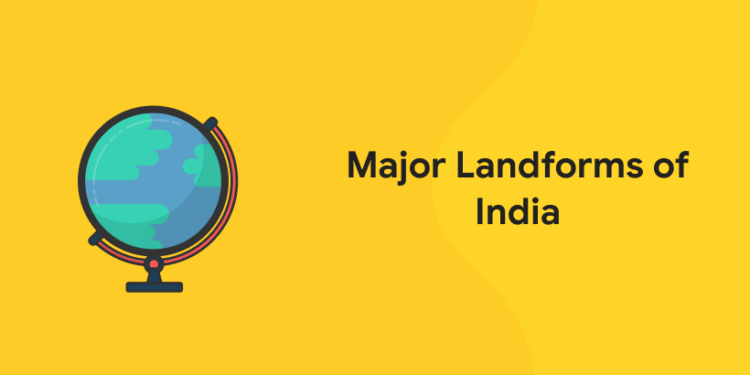Table of Contents
India is a vast country blessed with varied land forms. It is home to some of the most breathtaking sights and views. This beautiful country boasts of ice capped mountains, glaciers, fertile plains, enormous desert, islands etc. Let us have a detailed look at the major land forms of India.
The six major landforms of India are:
- The Northern and North-eastern Mountains
- The Northern Plain
- The Peninsular Plateau
- The Indian Desert
- The Coastal Plains
- The Islands
Prepare for General Knowledge Exam! Download Entri App!
The North and Northeastern Mountains
The North and Northeastern Mountains consist of the Himalayas and the Northeastern hills. It lies in the north eastern states of the country. Spread over an area of 500000 square kilometer, the Himalayas stretch from the Indian states of Jammu and Kashmir, Himachal Pradesh, Uttarakhand, Sikkim to Arunachal Pradesh. The Himalayas are young fold mountains and they are divided into three main ranges that run parallel to each other. They are the Greater Himalayas (which includes the Great Himalayas and the Trans-Himalayan range), Lesser/ Middle Himalayas ( or Himachal) and the Outer Himalayas (Siwalik ranges). The Himalayas stand like a wall of protection between the Indian subcontinent and the Central and East Asian countries.
The general orientation of these ranges is from northwest to the southeast direction in the northwestern part of India. The Himalayas in the Darjeeling and Sikkim regions lie in an east-west direction, while in Arunachal Pradesh they are from southwest to the northwest direction. In Nagaland, Manipur, and Mizoram, they are in the north-south direction.
The approximate length of the Great Himalayan range is 2,500 km from east to west and their width varies between160 to 400 km from north to south. They have snow covered peaks, big and small glaciers and deep gorges and are covered with dense forests.

On the basis of relief, alignment of ranges and other geomorphologic features, the Himalayas can be divided into the following sub-divisions:
- Kashmir (or Northwestern) Himalayas – It consists of a series of ranges such as the Karakoram, Ladakh, Zanskar, and Pir Panjal. The Kashmir Himalayas are also popular for the Karewa formations, which are useful for the cultivation of Zafran, a local variety of saffron.
- Himachal and Uttaranchal Himalayas – They are located approximately between the rivers Ravi in the west and the Kali (a tributary of Ghaghara) in the east.
- Darjeeling and Sikkim Himalayas – They are flanked by the Nepal Himalayas in the west and the Bhutan Himalayas in the east.
- Arunachal Himalayas – It extends from the east of the Bhutan Himalayas up to the Diphu pass in the east. Some of the prominent tribes of Arunachal Himalayas from west to east are the Monpa, Abor, Mishmi, Nyishi, and the Nagas.
- Eastern Hills and Mountains – Located in northeast India, they are known by different local names such as Patkai Bum, Naga hills, the Manipur hills in the North, and Mizo or Lushai hills in the South.
Prepare for General Knowledge Exam! Download Entri App!
Some Interesting Facts About Himalayas
- The name “Himalaya” means “the abode or house of snow” in Sanskrit.
- The Himalayas are the highest and longest of all young fold mountains of the world.
- The Pamir, known as the roof of the world, connects the Himalayas with the high ranges of Central Asia.
- Himalayas form an arcuate curve which is convex to the south.
- The Himalayas are wider in the west than in the east.
- The southern slopes of the Himalayas facing India are steeper and those facing the Tibetan side are generally gentler.
- The Himalayas separates India from the Tibetan plateau, and other ranges namely Hindu Kush and Patkai at north-eastern border with Burma.
- It has the tallest peak known as Mount Everest.
- The mountains are the major sources of water and forest wealth.
Significance of the North and Northeastern Mountains
- Himalayas are rich in minerals like gold, silver, copper etc.
- They influence the climate. The altitude of the Himalayas prevent the cold Siberian air masses from entering into India.
- They are also a source of perennial rivers, source of fertile soils, forest wealth, orchards etc.
- They object the flow of downhill winds from Central Asia; this protects the northern part of India from extreme cold in winters.
Attempt Free Mock Tests for General Knowledge! Download Entri App!
The Northern Plain
1: Who was the first woman President of India?
Between the Himalayas and the Peninsular Plateau are found the Great Northern Plains that stretch in an east-west direction for about 2,400 km. They lie to the south of the Shivaliks, separated by the Himalayan Frontal Fault (HFF). The southern boundary is a wavy irregular line along the northern edge of Peninsular India. On the eastern side, the plains are bordered by the Purvanchal hills. These plains extend from the state of Haryana, including Delhi, Uttarakhand, and Uttar Pradesh, parts of Rajasthan, Madhya Pradesh, Bihar, and Jharkhand to West Bengal. These continue to the west beyond the Punjab and Rajasthan and merge into Indus plain in the Pakistan. The northern plain has been formed by the interplay of the three major river systems, namely the Indus, the Ganga and the Brahmaputra along with their tributaries. This plain spreads over an area of 7 lakh sq. km. They have a width ranging from less than 200 km (Bihar) to 500 km (Punjab and Rajasthan). It is a densely populated physiographic division. With a rich soil cover combined with adequate water supply and favorable climate it is agriculturally a very productive part of India.
The major rivers in the northern plains are Ganga, Yamuna, Chambal, Betwa, Son, Ken, Ghahghra, Gandak, Kosi and Hoogley. The entire northern plains are made of alluvial soil and hence it is agriculturally a very productive part of India. These have been deposited by three important Himalayan river systems– the Indus, the Ganga and the Brahmaputra. It is drained by many other rivers like Yamuna, Ghaghara, Gandak etc.
The Northern Plain is divided into three sections:
The Punjab Plains – They form the western part of the northern plain. This is formed by the Indus and its tributaries; like Jhelum, Chenab, Ravi, Beas and Sutlej. Punjab and Haryana come under this plain
The Ganga Plain – It lies between the Yamuna catchment in the west to the Bangladesh border in the East. It has been formed by the sedimentation by the Ganga and Brahmaputra rivers. Haryana, Delhi, Uttar Pradesh, Bihar, part of Jharkhand and West Bengal lie in the Ganga plains.
The Brahmaputra Plain – It lies in the state of Assam.
The Northern Plains is also divided into four regions
- Bhabar
- Terai
- Bhangar
- Khadar
Some Interesting Facts About the Northern Plains
- It is also known as Indo – Gangetic plains.
- These plains are the largest alluvial tract in the world.
- It is one of the world’s most intensively farmed areas.
- They have very suitable climate all through the year.
Significance of the Northern Plains
- It supports over 40 percent of the total population of the country.
- These are among the largest plains of the world.
- The sedimentary rocks of the plains contain petroleum and natural gas deposits.
- The rivers here have gentle gradients which makes them navigable over long distances.
- Punjab, Haryana and the western part of Uttar Pradesh, which lie in the Northern Plain, is known as the granary of India.
Attempt Free Mock Tests for General Knowledge! Download Entri App!
Free UPSKILLING Courses!
Take your first step toward mastering in-demand skills, acing interviews, and securing top-tier jobs with Entri's free upskilling courses.
Start Learning!The Peninsular Plateau
The presence of the plateau adds to the geographical beauty of India. It came into existence with the tectonic shift in Gondwanaland. As a result of this ancient shift, a triangular-shaped plateau was formed and is characterized by curved hills, and channels. The Peninsular plateau is composed of the old crystalline, igneous and metamorphic rocks. Three different mountain ranges, the Aravallis, the Vidhyas, and the Satpuras, surround the Peninsular Plateau. The plateau which is roughly triangular in shape has it’s base coinciding with the southern edge of the great plain of North India and the apex of the triangular plateau is at Kanyakumari. The Peninsular Plateau covers the eight states namely Rajasthan, Maharashtra, Gujrat, Telangana, Tamil Nadu, Karnataka, Kerala and Odisha. It covers a total area of about 16 lakh sq km. The height of the plateau varies from region to region and the average height of the plateau is 600 to 900 m above sea level. Some of the important physiographic features of this region are tors, block mountains, rift valleys, spurs, bare rocky structures, series of hummocky hills and wall-like quartzite dykes offering natural sites for water storage.
This plateau consists of two broad divisions, namely, the Central Highlands and the Deccan Plateau. The part of the Peninsular plateau lying to the north of the Narmada river covering a major area of the Malwa plateau is known as the Central Highlands. The Deccan Plateau is a triangular landmass that lies to the south of the river Narmada.
The Central Highlands consists of:
- Malwa Plateau
- Chotanagpur Plateau
- Meghalaya Plateau
- Vidhya Range
- Satpura Range
- Aravali Range
The Deccan Plateau is divided to following sub-regions:
- Andhra Plateau
- Maharashtra Plateau
- Karnataka Plateau
- Eastern plateaus
- Western Ghats
- Eastern Ghats
The Deccan Plateau is higher in the west and slopes gently eastwards. An extension of the plateau is also visible in the northeast, locally known as the Meghalaya, Karbi-Anglong Plateau and North Cachar Hills. It is separated by a fault from the Chotanagpur Plateau. Three prominent hill ranges from the west to the east are the Garo, the Khasi and the Jaintia Hills. The Western Ghats and the Eastern Ghats mark the western and the eastern edges of the Deccan Plateau respectively. The Anamudi (2695 Metre) of Kerala is the highest peak of peninsular India.
Some Interesting Facts About the Peninsular Plateau
- The Peninsular Plateau is a one of the oldest landforms of earth.
- Since few hundred million years, Peninsular block has been a land area and has never been submerged beneath the sea except in a few places.
- Peninsular plateau has black soil area known as Deccan Trap. This is of volcanic origin, hence, the rocks are igneous.
Attempt Free Mock Tests for General Knowledge! Download Entri App!
The Indian Desert
The Great Indian Desert is also known as the Thar Desert. It is a sandy plain which lies towards the western margins of the Aravalli Hills. The Indian Desert is an undulating sandy plain covered with sand dunes. This region receives very low rainfall ranging from about 4 inches or less in the west to about 20 inches in the east and has arid climate with low vegetation cover. More than 60% of the desert lies in the Indian state of Rajasthan and a certain portion extends into Gujarat, Punjab, and Haryana. It is also partly located in Punjab and Sindh provinces in eastern Pakistan. It covers around 200,000 square km of territory. It is bordered by the Indus River plain to the west, the Punjab Plain to the north and northeast, the Aravalli Range to the southeast, and the Rann of Kachchh to the south. The desert has high and low sand dunes separated by sandy plains and low barren hills known as bhakars.
Some Interesting Facts About the Indian Desert
- It is considered as the hottest region in the country.
- The grass in the desert has multi-purpose medicinal features.
- The terrain of Thar desert facilitates the growth of cotton and wheat.
- The desert is the 18 largest subtropical desert on Earth
- It is also the largest wool-producing region of India.
- It supports many locally and globally threatened species, including the great Indian bustard, houbara bustard, sarus crane.
Apart from the Great Indian Desert, there are several other minor deserts in India like White Salt desert, Spiti Valley desert etc.
Attempt Free General Knowledge Quiz! Register Here!
The Coastal Plains
The Coastal Plains of India lie on either side of the Deccan Plateau, along the western and eastern coasts of India. They extend for about 6,150 km from the Rann of Kutch in the west to West Bengal in the east. The Peninsular plateau is flanked by stretch of narrow coastal strips, running along the Arabian Sea on the west and the Bay of Bengal on the east. The western coast, sandwiched between the Western Ghats and the Arabian Sea, is a narrow plain.
It consists of three sections – The northern part of the coast is called the Konkan (Mumbai – Goa), the central stretch is called the Kannad Plain, while the southern stretch is referred to as the Malabar coast. The plains along the Bay of Bengal are wide and level. In the northern part, it is referred to as the Northern Circar, while in the southern part is known as the Coromandel Coast. Large rivers, such as the Mahanadi, the Godavari, the Krishna and the Kaveri have formed extensive delta on this coast. Lake Chilika is an important feature along the eastern coast.
Significance of the Coastal Plains
- They are the centers of national and international trade.
- They provide important hinterlands for big ports.
- It has 13 major sea ports that facilitate India’s foreign trade and provides numerous employment opportunities.
- They provide economic activities like mining, fishing, salt farming, shipbuilding, metallurgy, manufacturing, etc.
Attempt Free Mock Tests for General Knowledge! Download Entri App!
Free UPSKILLING Courses!
Take your first step toward mastering in-demand skills, acing interviews, and securing top-tier jobs with Entri's free upskilling courses.
Start Learning!Islands
In India, there are 1,382 islands including uninhabited ones. India has two groups of islands – Lakshadweep Islands group lying close to the Malabar coast of Kerala and Andaman and Nicobar islands located in the Bay of Bengal extending from north to south. Andaman and Nicobar islands are bigger in size and are more numerous and scattered. Other than these two groups there are islands in Indo-Gangetic Delta and between India and Sri Lanka.
Andaman and Nicobar Islands were formed due to collision between Indian Plate and Burma Minor Plate. Most of these islands are made of tertiary sandstone, limestone and shale resting on basic and ultrabasic volcanoes. Lakshadweep Islands are coral islands and are a part of Reunion Hotspot volcanism.
Andaman and Nicobar Islands
- It is composed of a total of 265 big and small islands.
- The Andaman and Nicobar islands extends to a distance of about 590 km.
- They are divided into three main islands – North, Middle and South.
- Among the Nicobar islands, the Great Nicobar is the largest.
- The Barren and Narcondam Islands, which lie to the north of Port Blair, are volcanic islands. These are the only active volcanoes in India.
- Some of the islands are fringed with coral reefs, many of them are covered with thick forests and most of the islands are mountainous.
Lakshadweep Islands
- The Lakshadweep Islands are a group of 25 small islands.
- They are widely scattered about 200 to 500 km south- west of the Kerala coast.
- They are surrounded by fringing reefs.
- Amendivi Islands are the northern most and the Minicoy island is the southern most island. Minicoy island is also the largest island.
These island groups are of great strategic importance for the country. There is great diversity of flora and fauna in this group of islands too. These islands lie close to equator and experience equatorial climate and has thick forest cover.
Significance of the Islands
- They offer tremendous scope for nature lovers and eco tourists.
- There are adventurous sports like water rafting, boat cruise, sea walk, snorkeling, swimming and scuba diving etc.
- They provide sites for fishing and port activities.
The key point to clear an exam lies in methodical and planned preparation. If you are a candidate who wants to pursue your dream career and looking for a good start, Entri App has got it covered for you. Entri App provides a great online platform for all those aspiring to appear for various bank exams, government exams and other competitive exams. Our team of experts provide short and precise video classes which helps in learning the concepts. Users get access to flash cards and quizzes and can attempt unlimited mock exams with the same pattern as that of the real exams. We also provide PDFs of previous years’ question papers with solutions.
Prepare for General Knowledge Exam! Download Entri App!












